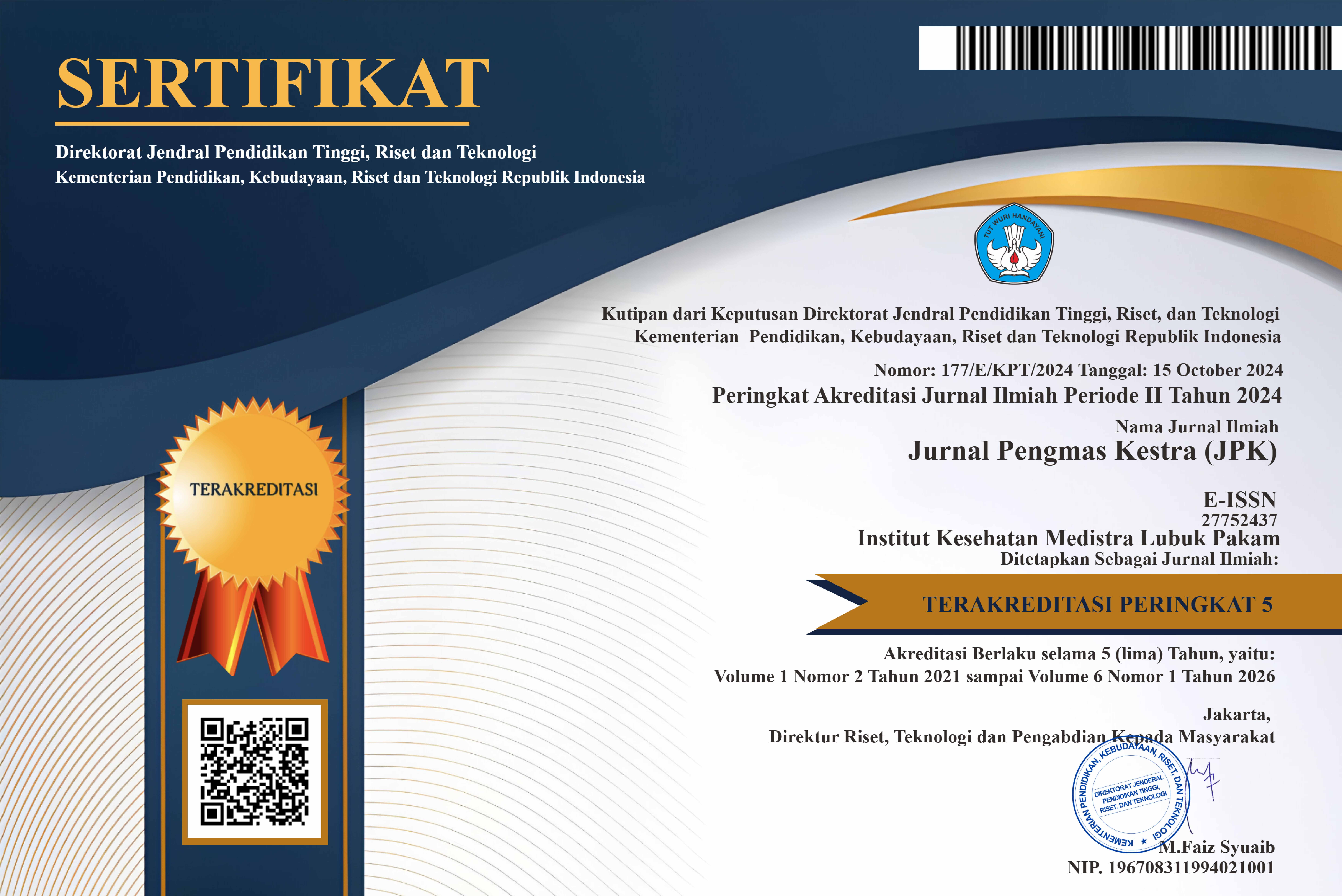Education About Posture Disorders In Elementary School Children
DOI:
https://doi.org/10.35451/ensmbx69Keywords:
Gangguan posturAbstract
Postural disorders in children are abnormalities in body alignment that can lead to long-term musculoskeletal health issues. Poor posture can cause muscle imbalance, chronic pain, and even growth problems. Contributing factors include incorrect sitting habits, excessive gadget use, lack of physical activity, and heavy school bags. Education for children and parents on proper posture is an important strategy to prevent these issues. This community service activity was conducted in Sidodadi Village, Beringin District, involving elementary students and their parents. The results showed that the majority of participants were unaware of ideal posture and the importance of early detection of disorders such as kyphosis, scoliosis, and lordosis. Through this education, participants gained awareness about the importance of maintaining good daily habits to support healthy posture.
References
[1] Macedo, R. B., et al. (2021). Postural changes in school children: a cross-sectional study. BMC Pediatrics, 21(1), 95.
[2] Rusek, W., et al. (2022). Physical activity level and posture in children: A study of the correlation. Journal of Human Kinetics, 82, 191–200.
[3] Zaina, F., et al. (2021). Postural screening and intervention in children: What the evidence says. European Journal of Physical and Rehabilitation Medicine, 57(1), 65–73.
[4] World Health Organization (2020). Guidelines on physical activity and sedentary behavior. Geneva: WHO.
[5] Silva, A. G., et al. (2022). Sedentary behavior and postural risks in children and adolescents: A review. Journal of Bodywork and Movement Therapies, 28, 50–56.
[6] Fong, D. Y. T., et al. (2021). Posture-related health knowledge among school-aged children. BMC Public Health, 21(1), 451.
[7] Gómez-López, M., et al. (2022). Educational interventions to prevent spinal deformities in schoolchildren. Children, 9(2), 246.
[8] Campana, M., et al. (2021). Reliability of postural screening tools in school settings. Children, 8(6), 470.
[9] Rodríguez-Almagro, D., et al. (2021). Effects of educational programs on body posture in schoolchildren. International Journal of Environmental Research and Public Health, 18(7), 3617.
[10] Trigueiro, J., et al. (2022). Influence of school ergonomics on children's posture. Applied Ergonomics, 95, 103454.
[11] Silva, A. G., et al. (2022). Sedentary behavior and postural risks in children and adolescents: A review. Journal of Bodywork and Movement Therapies, 28, 50–56.
[12] Campana, M., et al. (2021). Reliability of postural screening tools in school settings. Children, 8(6), 470.
[13] Rusek, W., et al. (2022). Physical activity level and posture in children: A study of the correlation. Journal of Human Kinetics, 82, 191–200.
[14] Gómez-López, M., et al. (2022). Educational interventions to prevent spinal deformities in schoolchildren. Children, 9(2), 246.
[15] Trigueiro, J., et al. (2022). Influence of school ergonomics on children's posture. Applied Ergonomics, 95, 103454.
[16] Macedo, R. B., et al. (2021). Postural changes in school children: a cross-sectional study. BMC Pediatrics, 21(1), 95.
[17] Zaina, F., et al. (2021). Postural screening and intervention in children: What the evidence says. European Journal of Physical and Rehabilitation Medicine, 57(1), 65–73.
[18] Fong, D. Y. T., et al. (2021). Posture-related health knowledge among school-aged children. BMC Public Health, 21(1), 451.
[19] González-Medina, G., et al. (2023). School-based physical activity programs and their effect on musculoskeletal health: A systematic review. International Journal of Environmental Research and Public Health, 20(2), 1144.
[20] Lemos, T. V., et al. (2021). Effects of active breaks during classes on musculoskeletal symptoms and physical performance in children: A cluster randomized controlled trial. BMC Pediatrics, 21(1), 55.
Downloads
Published
Issue
Section
License
Copyright (c) 2025 Siti Sarah Bintang Sarah Bintang, Elvida Rahmi Zein, Miftahul Jannah, Dwi Handayani

This work is licensed under a Creative Commons Attribution 4.0 International License.
Copyright in each article is the property of the Author.




















